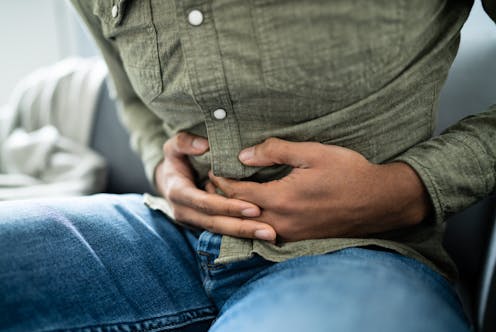Diarrhoea, stomach ache and nausea: the many ways COVID-19 can affect your gut
- Written by Vincent Ho, Senior Lecturer and clinical academic gastroenterologist, Western Sydney University

Media reports earlier this week described a Queensland nurse with stomach pains who went on to test positive for COVID-19.
Could stomach pains be another symptom of COVID-19? And if you have stomach pains, should you get tested?
Although we might think of COVID-19 as a respiratory disease, we know it involves the gut. In fact SARS-CoV-2, the virus that causes COVID-19, enters our cells by latching onto protein receptors called ACE2. And the greatest numbers of ACE2 receptors are in the cells that line the gut.
COVID-19 patients with gut symptoms are also more likely to develop severe disease. That’s partly because even after the virus has been cleared from the respiratory system, it can persist in the gut of some patients for several days. That leads to a high level of virus and longer-lasting disease.
We also suspect the virus can be transmitted via the faecal-oral route. In other words, the virus can be shed in someone’s poo, and then transmitted to someone else if they handle it and touch their mouth.
Read more: We don't know for sure if coronavirus can spread through poo, but it's possible
What type of gut symptoms are we talking about?
A review of more than 25,000 COVID-19 patients found about 18% had gastrointestinal symptoms. The most common was diarrhoea followed by nausea and vomiting. Abdominal pain was considered rare. In another study only about 2% of COVID-19 patients had abdominal pain.
Some people believe COVID-19 causes abdominal pain through inflammation of the nerves of the gut. This is a similar way to how gastroenteritis (gastro) causes abdominal pain.
Another explanation for the pain is that COVID-19 can lead to a sudden loss of blood supply to abdominal organs, such as the kidneys, resulting in tissue death (infarction).
Are gut symptoms recognised?
The US Centers for Disease Control has added diarrhoea, nausea and vomiting to its list of recognised COVID-19 symptoms.
However, the World Health Organisation still only lists diarrhoea as a gastrointestinal COVID-19 symptom.
In Australia, nausea, diarrhoea and vomiting are listed as other COVID-19 symptoms, alongside the classic ones (which include fever, cough, sore throat and shortness of breath). But abdominal pain is not listed.
Advice about symptoms that warrant testing may vary across states and territories.
How likely is it?
Doctors often use the concept of pre-test probability when working out if someone has a particular disease. This is the chance a person has the disease before we know the test result.
What makes it difficult to determine the pre-test probability for COVID-19 is we don’t know how many people in the community truly have the disease.
We do know, however, COVID-19 in Australia is much less common than in many other countries. This affects the way we view symptoms that aren’t typically associated with COVID-19.
It’s far more common for people’s abdominal pain to be caused by something other than COVID-19. For example, about a quarter of people at some point in their lives are known to suffer from dyspepsia (discomfort or pain in the upper abdomen). But the vast majority of people with dyspepsia do not have COVID-19.
Similarly, irritable bowl syndrome affects about 9% of Australians, and causes diarrhoea. Again, the vast majority of people with irritable bowel syndrome do not have COVID-19.
So how about this latest case?
In the Queensland case, we know the nurse was worried he could have had COVID-19 because he was in close contact with COVID-19 patients.
As he seemed otherwise healthy before developing new abdominal symptoms, and considering he worked on a COVID ward, his pre-test probability was high. Doctors call this a “high index of suspicion” when there is a strong possibility someone may have symptoms due to a disease such as COVID-19.
What does this mean for me?
If you have new gastrointestinal symptoms and you’ve potentially been in contact with someone with COVID-19 or if you also have other classic COVID-19 symptoms (fever, cough, shortness of breath and sore throat) you should definitely get tested.
If you have just gastrointestinal symptoms, you may need to get tested if you’re in a “hotspot” area, or work in a high-risk occupation or industry.
If you have gastrointestinal symptoms alone, without any of these additional risk factors, there is no strong evidence to support testing.
Read more: 8 ways the coronavirus can affect your skin, from COVID toes, to rashes and hair loss
However, if COVID-19 becomes even more common in the community, these symptoms now regarded as uncommon for COVID-19 will become more common.
If you have concerns about any gastrointestinal symptoms, seeing your GP would be sensible. Your GP will provide a balanced assessment based on your medical history and risk profile.
Read more: 4 unusual things we've learned about the coronavirus since the start of the pandemic
Authors: Vincent Ho, Senior Lecturer and clinical academic gastroenterologist, Western Sydney University





